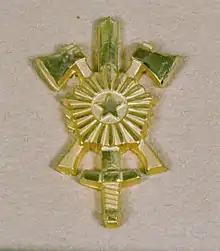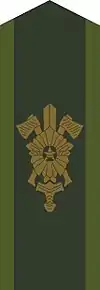Swedish Engineer Troops
The Swedish Engineer Troops (Swedish: Ingenjörtrupperna, I) is the engineer branch of the Swedish Army. The brach were formed after the Defence Act of 1936. It provides military engineering and other technical support to the Swedish Armed Forces. Today, it consists of a single unit, the Göta Engineer Regiment (Ing 2) and two schools, the Swedish Army Field Work School (Fältarbetsskolan, FarbS) and the EOD School (Amröjskolan, AmröjS).
| Swedish Engineer Troops | |
|---|---|
| Ingenjörtrupperna | |
 Branch insignia m/60. | |
| Active | 1937–present |
| Country | Sweden |
| Allegiance | Swedish Armed Forces |
| Branch | Swedish Army |
| Type | Engineer corps |
| Part of | Swedish Armed Forces Headquarters[lower-alpha 1] |
| Insignia | |
| Cap badge |  |
History
In the 1600s and 1700s, special engineer (or pioneer units) were organized. Fortifikationen ("Royal Engineers"[1]) were established in 1635 as a special corps for construction of fortifications.[2] The task of Fortifikationen was to build and maintain the country's land and coastal fortifications and other military buildings.[3] In 1811, the Fortifikationen was amalgamated with the Field Surveying Corps (Fältmätningskåren) to the Engineer Corps (Ingenjörskåren). This consisted, among other things, of a fortification brigade. In 1867 the Engineer Corps was renamed the Fortifikationen. From 1855, sapper companies, a pontoon battalion, a field-signaling company and engineer troops were added to the Fortifikationen.[3] The service branch expanded greatly towards the late 1800s, and in 1901 there were four corps;[2] the Svea Engineer Corps (Ing 1), Göta Engineer Corps (Ing 2), Field Telegraph Corps (Ing 3), and Boden Engineer Corps (Ing 4).
According to the Defence Act of 1925, the Swedish Engineer Troops now came to consist of two field engineering corps (Svea and Göta, located in Stockholm and Eksjö), the Field Telegraph Corps (Stockholm) and Boden Engineer Corps. Svea Engineer Corps was organized on a corps staff, two field engineering companies, two military bridge companies, a fortress engineering company (Vaxholm) and a ordnance (sapper) company.[4] Göta Engineer Corps was organized on a corps staff, three field engineering companies, a military bridge company, a fortress engineering company (Karlskrona) and a ordnance (sapper) company. The Field Telegraph Corps was organized on corps staff, two field telegraph companies, two radio companies and an ordnance company. The Boden Engineer Corps was organized on a corps staff, a field engineering company, a fortress engineering company, a military bridge company, a telegraph company and a ordnance (sapper) company.[4]
The Swedish Engineer Troops constituted after the Defence Act of 1936 a special service branch, including three engineer corps: Svea Engineer Corps (Ing 1) in Solna, Göta Engineer Corps (Ing 2) in Eksjö and Boden Engineer Corps (Ing 4, later Ing 3) in Boden.[5] It was established when the Fortifikationen was split into the Swedish Engineer Troops, Swedish Army Signal Troops and the Swedish Fortification Corps.[6] A school to train officers in the engineer troops and to train other officers in the field working service was established in 1943 under the name Engineer Troop School (Ingenjörtruppskolan, IngS). It changed its name in 1952 to the Swedish Army School of Field Works (Arméns fältarbetsskola, FältarbS). On 1 June 1981 the Swedish Engineers [Cadet and] Officer Candidate School (Ingenjörtruppernas kadett- och aspirantskola, IngKAS) was amalgamated with the Swedish Army School of Field Works. It ceased and was part of the Swedish Army Field Works Center (Arméns fältarbetscentrum, FarbC) from 1 July 1991.[7]
The Swedish Army Field Works Center was disbanded in 1997 and the Swedish Army Field Work School (Fältarbetsskolan, FarbS) continued operations together with the EOD School (Amröjskolan, AmröjS), both sorting under Göta Engineer Regiment (Ing 2) which since 2005 is the only remaining active engineer unit in the Swedish Engineer Troops.
Units

Inspector of the Swedish Engineer Troops
The head of the Engineer Troops was called Ingenjörinspektören ("Inspector of the Swedish Engineer Troops").[8] In the years 1966-1991, the Engineer Troops and the Signal Troops had a joint branch inspector; the Inspector of the Swedish Army Engineer Corps and Signal Corps (Ingenjörinspektör- och Signalinspektören).[note 1] From 1991, the two branches received an inspector each, and the title of the engineer troops was shortened to the Engineer Inspector.[10] In connection with the decommissioning of Swedish Army Field Work Center (Arméns fältarbetscentrum), the position of Engineer Inspector disappeared.
- 1937–1941: Sven Alin
- 1940–1941: Per (Pelle) Högstedt
- 1941–1946: Sigurd Rahmqvist
- 1946–1953: Inge Hellgren
- 1953–1963: Stig Berggren
- 1963–1967: Gunnar Smedmark
- 1967–1967: Harald Smith (acting)
- 1968–1969: Harald Smith
- 1969–1975: Åke Bernström
- 1975–1982: Kåre Svanfeldt
- 1982–1986: Owe Dahl
- 1986–1991: Bertil Lövdahl
- 1991–1993: Lars-Åke Persson
- 1993–1997: Christer Ljung
- 1997–1997: Björn Svensson
See also
Footnotes
- The branch was subordinate the Inspector of the Swedish Engineer Troops (Ingenjörinspektören) at the Engineer Department of the Army Staff from 1942 to 1991. After that, it was subordinate to the commander of the Swedish Army Field Works Center (1991–1997), the commander of the Swedish Army Center (1997–2000), the Joint Forces Command (2000–2005), and the Swedish Armed Forces Headquarters from 2005.
Footnotes
- Also called the Director of Swedish Army Engineers and Signals.[9]
References
Notes
- Kärre & Grove 1948, p. 231
- Degerström, Ericson & Söderberg 2005
- National Archives of Sweden - A.
- Bring 1925, pp. 276–277
- Gunnarsson 1948, p. 759
- Bertilsson, p. 22
- National Archives of Sweden - B.
- Gullberg 1977, p. 349.
- Gullberg 1977, p. 1411.
- Johansson, Dicander & Westergren 2017
Print
- Bring, Samuel E., ed. (1925). Svenska kalendern 1926: en årsbok för alla (in Swedish). Vol. 21. Uppsala: Almqvist & Wiksell. SELIBR 869835.
- Gullberg, Ingvar E. (1977). Svensk-engelsk fackordbok för näringsliv, förvaltning, undervisning och forskning [A Swedish-English dictionary of technical terms used in business, industry, administration, education and research] (in Swedish) (2nd ed.). Stockholm: Norstedt. ISBN 91-1-775052-0. SELIBR 8345587.
- Gunnarsson, Gunnar, ed. (1948). Norstedts uppslagsbok: illustrerad encyklopedi i ett band (PDF) (in Swedish) (4th, rev. ed.). Stockholm: Norstedt. SELIBR 12469179.
- Kärre, Karl; Grove, Grenville (1948). Engelsk-Svensk ordbok: skolupplaga [English-Swedish Dictionary: School Edition] (in Swedish) (2nd ed.). Stockholm. SELIBR 2220598.
{{cite book}}: CS1 maint: location missing publisher (link)
Web
- Bertilsson, Sven. "En sammanställning över arméns telefonmateriel från 1870-talet till 1970-talet" (PDF) (in Swedish). Försvarets Historiska Telesamlingar. p. 22. Retrieved 23 March 2018.
- Degerström, Anders; Ericson, Lars; Söderberg, Ulf (June 2005). "FÖRSVARETS REGIONALA OCH LOKALA ORGANISATION" [SWEDISH DEFENSE REGIONAL AND LOCAL ORGANIZATION] (in Swedish). National Archives of Sweden. Retrieved 23 March 2018.
- Johansson, Lennart; Dicander, Lars; Westergren, Per-Olof (2017-01-21). "Bertil Lövdahl". Dagens Nyheter (in Swedish). Retrieved 23 March 2018.
- "Fortifikationen (1635 – 1937)" (in Swedish). National Archives of Sweden. Retrieved 26 March 2018.
- "Arméns fältarbetsskola (1943 – 1961)" [Swedish Army School of Field Works (1943 – 1961)] (in Swedish). National Archives of Sweden. Retrieved 26 March 2018.
Further reading
- Berggren, Stig (1965). Ingenjörtrupperna i atomåldern (in Swedish). Stockholm: Folkförsvaret. SELIBR 1245500.
- Ingenjörtrupperna 1855-1955 (in Swedish). Filipstad: Filipstads tr.-ab. 1955. SELIBR 1453657.
- Westrin, Theodor, ed. (1910). "Ingenjörtrupper". Nordisk familjebok: konversationslexikon och realencyklopedi. Uggleupplagan (in Swedish). Vol. 12 (New, rev. and rich ill. ed.). Stockholm: Nordisk familjeboks förl. pp. 637–643. SELIBR 8072220. Retrieved 26 March 2018.